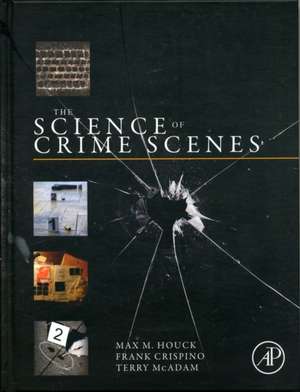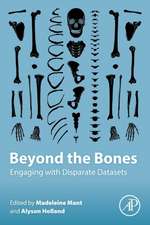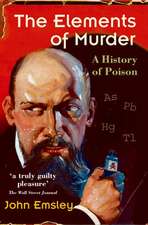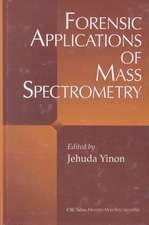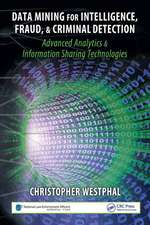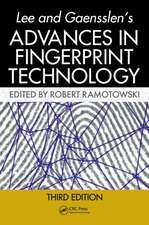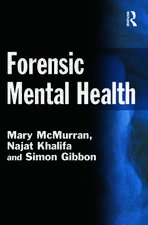The Science of Crime Scenes
Autor Max M. Houck, Frank Crispino, Terry McAdamen Limba Engleză Hardback – 5 sep 2012
The book provides in-depth coverage of disasters and mass murder, terror crime scenes, and CBRN (chemical, biological, radioactive and nuclear) – topics not covered in any other text. It includes an instructor website with lecture slides, test bank, outlines, definitions, and activities, along with a student companion site with an image collection.
This text will be of interest to advanced undergraduate and graduate students in forensic science programs, as well as to forensic practitioners and crime scene technicians.
- Offers a science-based approach to crime scene investigation
- Includes in-depth coverage of disasters and mass murder, terror crime scenes, and CBRN (chemical, biological, radioactive and nuclear) – not covered in any other text
- Written by an international trio of authors with decades of crime scene experience
- Instructor website with lecture slides, test bank, outlines, definitions, and activities, and a student companion site with an image collection
| Toate formatele și edițiile | Preț | Express |
|---|---|---|
| Hardback (2) | 427.04 lei 5-7 săpt. | |
| ELSEVIER SCIENCE – 5 sep 2012 | 427.04 lei 5-7 săpt. | |
| ELSEVIER SCIENCE – 11 iul 2017 | 446.72 lei 5-7 săpt. | +93.14 lei 4-10 zile |
Preț: 427.04 lei
Preț vechi: 599.66 lei
-29% Nou
Puncte Express: 641
Preț estimativ în valută:
81.72€ • 88.74$ • 68.65£
81.72€ • 88.74$ • 68.65£
Carte tipărită la comandă
Livrare economică 15-29 aprilie
Preluare comenzi: 021 569.72.76
Specificații
ISBN-13: 9780123864642
ISBN-10: 012386464X
Pagini: 408
Ilustrații: 50 illustrations
Dimensiuni: 189 x 246 x 28 mm
Greutate: 1.25 kg
Editura: ELSEVIER SCIENCE
ISBN-10: 012386464X
Pagini: 408
Ilustrații: 50 illustrations
Dimensiuni: 189 x 246 x 28 mm
Greutate: 1.25 kg
Editura: ELSEVIER SCIENCE
Public țintă
Advanced undergraduate and graduate students in forensic science programs; forensic practitioners and crime scene techniciansCuprins
SECTION 1: THE SCIENCE OF CRIME SCENE INVESTIGATION1.0 The "forensic mindset"1.1 From scene to laboratory to court2.0 What is a crime scene?2.1 Crime scene intelligence: Connecting people, places, and things
SECTION 2: PERSONNEL AND PROCEDURES3.0 Personnel3.1 First responder on the scene3.2 The investigator in charge3.3 The forensic team: Officers, scientists and specialists3.4 Non-forensic personnel: Superiors, officials, and the media4.0 General crime scene procedure4.1 “Freezing the scene and the 3R’s (Recognize, Record and Recover)4.2 The chain of custody4.3 Recording the scene: Sketching, photography, and video
SECTION 3: DETECTION AND RECONSTRUCTION5.0 Searching for evidence: Recovery5.1 Detecting5.2 Collection5.3 Preserving5.4 Submitting evidence to the laboratory6.0 Evidence types and enhancement6.1 Chemical evidence6.2 Biological evidence6.3 Impression evidence6.4 Other evidence types7.0 Crime scene reconstruction7.1 An archaeological approach7.2 Bloodstain pattern analysis7.3 Photogrammetry and 3D reconstruction
SECTION 4: SPECIAL CRIME SCENES8.0 Special crime scenes8.1 Disaster and mass fatalities8.2 Terrorist crime scenes8.3 CBRN crime scenes8.4 Underwater and underground crime scenes
SECTION 2: PERSONNEL AND PROCEDURES3.0 Personnel3.1 First responder on the scene3.2 The investigator in charge3.3 The forensic team: Officers, scientists and specialists3.4 Non-forensic personnel: Superiors, officials, and the media4.0 General crime scene procedure4.1 “Freezing the scene and the 3R’s (Recognize, Record and Recover)4.2 The chain of custody4.3 Recording the scene: Sketching, photography, and video
SECTION 3: DETECTION AND RECONSTRUCTION5.0 Searching for evidence: Recovery5.1 Detecting5.2 Collection5.3 Preserving5.4 Submitting evidence to the laboratory6.0 Evidence types and enhancement6.1 Chemical evidence6.2 Biological evidence6.3 Impression evidence6.4 Other evidence types7.0 Crime scene reconstruction7.1 An archaeological approach7.2 Bloodstain pattern analysis7.3 Photogrammetry and 3D reconstruction
SECTION 4: SPECIAL CRIME SCENES8.0 Special crime scenes8.1 Disaster and mass fatalities8.2 Terrorist crime scenes8.3 CBRN crime scenes8.4 Underwater and underground crime scenes
Recenzii
"The Science of Crime Scenes is a good reference for the crime scene investigator. It incorporates excellent tables, charts, and illustrations which can be a great aid when processing a scene…It does a good job in describing the total spectrum of factors which can impact crime scenes and provides the reader with the necessary knowledge and tools to successfully evaluate and process the scene of a crime." --Journal of Forensic Sciences, July 2013
"The text provides in-depth detail of the science behind the scene and demonstrates the latest methods and technologies - as well as the philosophy and history behind crime scene work." --Evidence Technology Magazine, July-August 2013
"…The Science of Crime Scenes is a good reference for the crime scene investigator. It incorporates excellent tables, charts, and illustrations which can be a great aid when processing a scene." --Journal of Forensic Sciences, 2013
"…The Science of Crime Scenes fits well within the framework of crime scene training and documents the nuances of the challenging tasks required of these specialized personnel. This reviewer’s recommendation is that forensic laboratories add The Science of Crime Scenes to their training literature, and allow analysts to garner invaluable insight from the highly experienced trio of authors." --Crime Scene, Volume 39, Issue 2, Spring 2013
"A half century has not dimmed skeptics' suspicions about the death of Marilyn Monroe at age 36, but the intervening decades have seen technological leaps that could alter the investigation were it to occur today… ‘The good news is we're very advanced from 50 years ago,’ said Max Houck, a forensic consultant and co-author of ‘The Science of Crime Scenes.’ ‘The bad news is, we're still trying to put it in context,’ he said." --Associated Press article on the 50th anniversary of Marilyn Monroe’s death carried on multiple publications and sites incuding CBSNews.com
"The text provides in-depth detail of the science behind the scene and demonstrates the latest methods and technologies - as well as the philosophy and history behind crime scene work." --Evidence Technology Magazine, July-August 2013
"…The Science of Crime Scenes is a good reference for the crime scene investigator. It incorporates excellent tables, charts, and illustrations which can be a great aid when processing a scene." --Journal of Forensic Sciences, 2013
"…The Science of Crime Scenes fits well within the framework of crime scene training and documents the nuances of the challenging tasks required of these specialized personnel. This reviewer’s recommendation is that forensic laboratories add The Science of Crime Scenes to their training literature, and allow analysts to garner invaluable insight from the highly experienced trio of authors." --Crime Scene, Volume 39, Issue 2, Spring 2013
"A half century has not dimmed skeptics' suspicions about the death of Marilyn Monroe at age 36, but the intervening decades have seen technological leaps that could alter the investigation were it to occur today… ‘The good news is we're very advanced from 50 years ago,’ said Max Houck, a forensic consultant and co-author of ‘The Science of Crime Scenes.’ ‘The bad news is, we're still trying to put it in context,’ he said." --Associated Press article on the 50th anniversary of Marilyn Monroe’s death carried on multiple publications and sites incuding CBSNews.com
